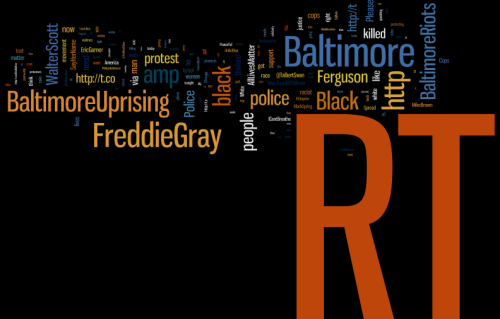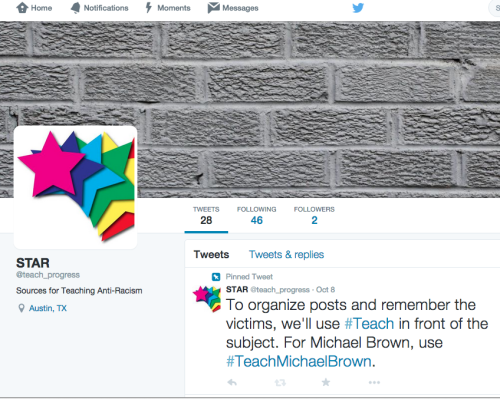As we approach the mid-semester mark, the Activist Twitter and Race research group is giving you a little behind-the-scenes view of what each group member has been working on. We think about, use, and relate to Twitter in a number of ways: as a pedagogical tool (Rhiannon, JB), as an aggregation and curation instrument (Pete) and as a data source (Axel).
Click through the slider below to get a little workshop view of our ongoing projects in the DWRL this semester.
[slider animation=”slide” slide_time=”5000″ slide_speed=”600″ slideshow=”false” random=”false” control_nav=”true” prev_next_nav=”false”] [slide]
Axel has been working on Twitter data collection and processing. On this blog, he has shared some of the problems he has run into with his code, and reflected about the rhetorical momentum that can be developed from these moments.
At the midway mark of the semester, it looks like things are falling into place and Axel’s algorithmic gears are getting some traction. There will be more detailed quantitative analyses in future posts, but for now: here is a word cloud of the most frequent terms co-occurring with #BlackLivesMatter in a corpus of 20,000,000+ tweets.

Without going to deep into interpretation, a couple of things can be taken away from this graphic. The majority of high-frequency (=big) words clearly relate to political concerns, places, and people important to the BlackLivesMatter movement. But note also that by far the most frequent “word” is the “RT” convention for retweeted material. “http” as found in URLs features prominently too. Practices like linking and retweeting, then, seem to be important for the movement and may help explain Twitter’s affordances for activist purposes.
Some other perhaps surprising ones to note: AllLivesMatter (in white, to the left of “Baltimore”), a hashtag often used in reactivist discourse, seems to cluster together with #BlackLivesMatter quite a bit. The term “now” also plays a big role (towards the top left of the cloud). These await closer qualitative interpretation in future posts.
[/slide] [slide]
Pete has been exploring Twitter as a curated project space. Posting a range of new media content, from think pieces to viral videos, he has been seeking out materials for secondary and post-secondary teachers to use in the classroom when discussing violence against black citizens, structural racism, and police brutality. Special attention has been paid to the #BlackLivesMatter movement as social activism that has developed and embraced the use of new media technologies.
He is also considering the use and value of hashtags as an organizing mechanism. He regularly reviews posts under the #BlackLivesMatter and its opposition, #AllLivesMatter, to see how users understand these tags and share content using them. He has been using #Teach before victims’ names as a way of both memorializing them and foregrounding their lives in discussions of these larger issues. Furthermore, he has been trying to draw attention to the project by employing trending hashtags in his posts.
[/slide] [slide]
Rhiannon is working on lesson plans that utilize Twitter to help students practice rhetorical analysis. As mentioned in previous posts, this year’s introductory course in writing and argumentation focuses on Race and Surveillance. So far, she’s designed lesson plans to help students use Twitter to write and research arguments. The image here shows part of a handout for an in-class activity that utilizes Twitter as part of the writing process. n the coming weeks, she’ll partner with DWRL Rhetoric instructors for in-class activity in which students use Twitter to identify logical fallacies and write arguments.
[/slide][slide]
https://youtube.com/watch?v=EHv4jtg-IBs
In the last post JB said he was going to make an instructional video on how Twitter can be used as a resource for mapping controversies for research papers. The video is still in production, but he wanted to take snippets of the audio and video being created to make a promotional video.
The promotional video is representative of what the end product will be…of a sort! The video is meant to show viewers what to expect from the visual aspect and introduce the content of the video. The audio is a rough cut of the introduction; it’s meant to give viewers an idea of how it will sound when finished.
The final product will be a fleshed out version of the promotion. JB has requested music from MobyGratis. The music (hopefully) will be used to mark the transitions between each section in the video and to accentuate the conversational tone of the audio. The sections of the video will be longer, and go into more detail, using discussing precisely how Twitter can be used to map controversies. Look for the final cut of the video to be finished in December!
[/slide] [/slider]
Feature Image credit: Alto a la Violencia by Rosaura Ochoa.




